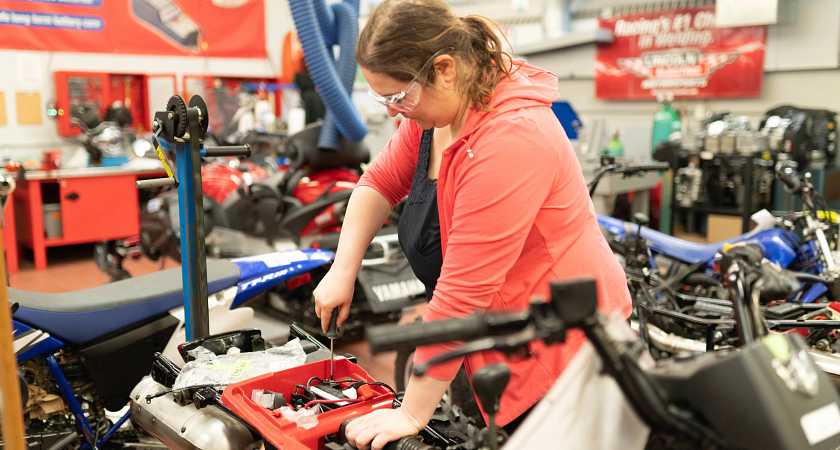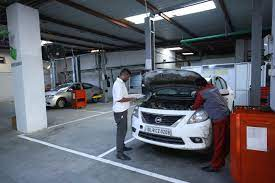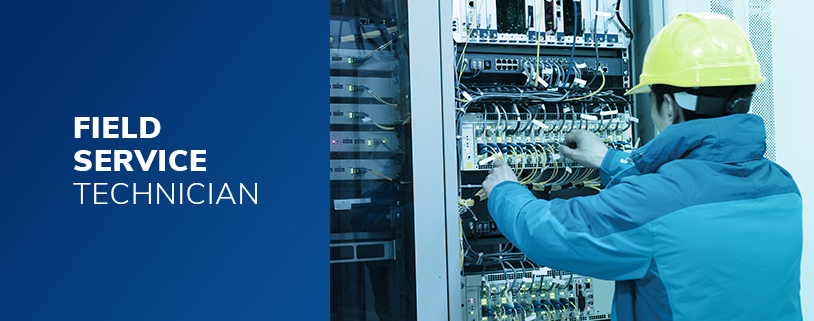Free Auto Body Technician Level 3 Course (6Months)
Auto Body Technician Level 3:
Brief Job Description
An Auto Body Technician Level 3 assists in repair of vehicles by carrying out work on the body and frame of a vehicle because of damage mostly due to major/ minor dents on the body. The individual also assists the Body Specialist to carry out specialised denting related jobs in the body shop.
Personal Attributes An individual on this job must have good interpersonal skills in addition to being a team player, as the job requires coordination with other Technicians. An individual on this job should also have good memory to recall the various tools used in the body shop and their storage location for easy retrieval. The individual must also have a technical bend of mind to have basic knowledge of vehicle structure and function to assist in the overall repairing dents and fabricating, assembling, or disassembling vehicle components

Plan and organise work to meet expected outcomes:
Elements and Performance Criteria
Work requirements including various activities within the given time and set quality standards
To be competent, the user/individual on the job must be able to:
PC1. keep immediate work area clean and tidy
PC2. treat confidential information as per the organisations guidelines
PC3. work in line with organisations policies and procedures
PC4. work within the limits of job role
PC5. obtain guidance from appropriate people, where necessary
PC6. ensure work meets the agreed requirements
Appropriate use of resources
To be competent, the user/individual on the job must be able to:
PC7. establish and agree on work requirements with appropriate people
PC8. manage time, materials and cost effectively
PC9. use resources in a responsible manner
Knowledge and Understanding (KU)
The individual on the job needs to know and understand:
KU1. the organisations policies, procedures and priorities for area of work, role and responsibilities in carrying out that work
KU2. the limits of responsibilities and when to involve others
KU3. specific work requirements and who these must be agreed with
KU4. the importance of having a tidy work area and how to do this
KU5. how to prioritize workload according to urgency and importance and the benefits of this
KU6. the organisations policies and procedures for dealing with confidential information and the importance of complying with these
KU7. the purpose of keeping others updated with the progress of work
KU8. who to obtain guidance from and the typical circumstances when this may be required
KU9. the purpose and value of being flexible and adapting work plans
KU10. how to complete tasks accurately by following standard procedures
KU11. technical resources needed for work and how to obtain and use these
Generic Skills (GS)
User/individual on the job needs to know how to:
GS1. write in at least one language
GS2. read instructions, guidelines/procedures
GS3. ask for clarification and advice from appropriate persons
GS4. communicate orally with colleagues
GS5. make a decision on a suitable course of action appropriate for accurately completing the task within resources
GS6. agree objectives and work requirements
GS7. plan and organise work to achieve targets and deadlines
GS8. deliver consistent and reliable service to customers
GS9. check own work and ensure it meets customer requirements
GS10. anomalies to the concerned persons
GS11. analyse problems and identify work-arounds taking help from
GS12. apply own judgement to identify solutions in different situations

Work effectively in a team:
Elements and Performance Criteria
Effective communication
To be competent, the user/individual on the job must be able to:
PC1. maintain clear communication with colleagues
PC2. work with colleagues
PC3. pass on information to colleagues in line with organisational requirements
PC4.. work in ways that show respect for colleagues
PC5. carry out commitments made to colleagues
PC6. let colleagues know in good time if cannot carry out commitments, explaining the reasons
PC7. identify problems in working with colleagues and take the initiative to solve these problems
PC8. follow the organisations policies and procedures for working with colleagues
PC9. ability to share resources with other members as per priority of tasks
Knowledge and Understanding (KU)
The individual on the job needs to know and understand:
KU1. the organisations policies and procedures for working withcolleagues, role and responsibilities in relation to this
KU2. the importance of effective communication and establishing goodworking relationships with colleagues
KU3. different methods of communication and the circumstances inwhich it is appropriate to use these
KU4. benefits of developing productive working relationships withcolleagues
KU5. the importance of creating an environment of trust and mutualrespect
KU6. whether not meeting commitments, will have implications onindividuals and the organisation
KU7. different types of information that colleagues might need and theimportance of providing this information when it is required
KU8. the importance of problems, from colleagues perspective andhow to provide support, where necessary, to resolve these
Generic Skills (GS)
User/individual on the job needs to know how to:
GS1. complete well written work with attention to detail
GS2. read instructions, guidelines/procedures
GS3. listen effectively and orally communicate information
GS4. make decisions on a suitable course of action or response
GS5. plan and organise work to achieve targets and deadlines
GS6. check that the work meets customer requirements
GS7. deliver consistent and reliable service to customers
GS8. apply problem solving approaches in different situations
GS9. apply balanced judgements to different situations
GS10. apply good attention to detail
GS11. check that the work is complete and free from errors
GS12. get work checked by peers
GS13. work effectively in a team environment

Maintain a healthy,safe and secure working environment:
Elements and Performance Criteria
Resources needed to maintain a safe, secure working environment
To be competent, the user/individual on the job must be able to:
PC1. comply with organisations current health,safety and security policies and procedures
PC2. report any identified breaches in health,safety, and security policies and procedures to the designated person
PC3.. Coordinate with other resources at the workplace to achieve the healthy, safe and secure environment for all incorporating all government norms esp. for emergency situations like fires,earthquakes etc.
PC4. identify and correct any hazards like illness, accidents, fires or any other natural calamity safely and within the limits of individuals authority
PC5. report any hazards outside the individuals authority to the relevant person in line with organisational procedures and warn other people who may be affected
PC6. follow organisations emergency procedures for accidents, fires or any other natural calamity
PC7. identify and recommend opportunities for improving health,safety, and security to the designated person
PC8. complete all health and safety records are updates and procedures well defined
Knowledge and Understanding (KU)
The individual on the job needs to know and understand:
KU1. legislative requirements and organisations procedures for health, safety and security and individuals role and responsibilities in relation to this
KU2. what is meant by a hazard, including the different types of health and safety hazards that can be found in the workplace
KU3. how and when to report hazards
KU4. the limits of responsibility for dealing with hazards
KU5. the organisations emergency procedures for different emergency situations and the importance of following these
KU6. the importance of maintaining high standards of health, safety and security
KU7. implications that any non-compliance with health, safety and security may have on individuals and the organisation
KU8. different types of breaches in health, safety and security and how and when to report these
KU9. evacuation procedures for workers and visitors
KU10. how to summon medical assistance and the emergency services,where necessary
KU11. how to use the health, safety and accident reporting procedures and the importance of these
Generic Skills (GS)
User/individual on the job needs to know how to:
GS1. complete accurate, well written work with attention to detail
GS2. read instructions, guidelines/procedures/rules
GS3. listen and orally communicate information
GS4. make decisions on a suitable course of action or response
GS5. plan and organise work to achieve targets and deadlines
GS6. build and maintain positive and effective relationships withcolleagues and customers
GS7. apply problem solving approaches in different situations
GS8. analyse data and activities
GS9. apply balanced judgements to different situations
GS10. apply good attention to detail
GS11. check that the work is complete and free from errors
GS12. get work checked by peers
GS13. work effectively in a team environment

Assist in the repair and replacement of vehicle body and chassis components:
Elements and Performance Criteria
Assist in repair & replacement of vehicle body and chassis components
To be competent, the user/individual on the job must be able to:
PC1. . assist the senior body technician to assess the overall damage to vehicle body and chassis components
PC2.. follow supervisors instructions as to which parts to restore or replace with respect to the auto body/ chassis components
PC3. . select, calibrate and use the appropriate tools and equipment for the body component/ chassis repair of the vehicle
PC4. . remove upholstery, accessories, electrical window-and-seat-operating equipment, and trim to gain access to vehicle bodies and fenders
PC5. . cut and tape plastic separating film to outside repair areas to avoid damaging surrounding surfaces during repair procedure, and remove tape and wash surfaces after repairs are complete
PC6. . assist in performing repair work under supervision of senior body technician such as: body panel repair minor structural damage major welded panels body components using lead wiping major sectional repair chassis/ frame and associated components
PC7. . assist in removal and replacement related work under supervision of Senior Body Technician such as: vehicle body panels, panel sections and ancillary fittings protector mouldings, transfers and decals mechanical units/assemblies electrical/electronic units/assemblies
PC8.. install various vehicle component seals
PC9. . prepare surface and apply window tainting
PC10. . file, grind, sand and smooth fill or repair surfaces, using power tools and hand tools
PC11.. assist in clamping frames and sections to alignment machines that use hydraulic pressure to align damaged components
PC12. . assist in removal of damaged sections of vehicles using metal-cutting guns, air grinders and wrenches, and install replacement parts using wrenches or welding equipment
PC13. . assist in mixing polyester resins and hardeners to restore damaged areas
PC14. . assist in fitting and securing windows, vinyl roofs, and metal trim to vehicle bodies, using caulking guns, adhesive brushes, and mallets
PC15. . assist in filling small dents that cannot be worked out with plastic or solder
PC16. . assist in removal of small pits and dimples in body metal using pick hammers and punches
PC17. . ensure any malfunctions or repair requirements observed in vehicles (and beyond own scope of work) are reported to the concerned person
PC18. . ensure any malfunctions observed in tools and equipment are reported to the concerned person
PC19.. clean work areas, using air hoses, to remove damaged material and discarded fiberglass strips used in repair procedures
PC20.. ensure that trainings organized by the OEM from time-to-time are attended and knowledge levels are upgraded (esp. in case of newly launched products, product refreshes)
Knowledge and Understanding (KU)
The individual on the job needs to know and understand:
KU1. standard operating procedures of the Organisation/ Dealership for inspection and repair of vehicles for the body/ chassis components
KU2. standard operating procedures for repair and replacement of automotive body parts mandated by the OEM
KU3. safety requirements for equipment and components (e.g. preventing/ dealing with oil spillage and inflammable materials)
KU4. standard operating procedures recommended by the Dealership/ Suppliers/OEM for using tools and equipment to be followed as per the manufacturer instructions (e.g. maintaining safety while using welding and soldering equipment)
KU5. documentation requirements for each procedure carried out as part of roles and responsibilities as specified by the organization
KU6. organisational and professional code of ethics and standards of practice
KU7. safety, health, environmental policies and regulations for the workplace as well as for Automotive trade in general (e.g. safe practices while working in pits/ under vehicles)
KU8. workplace policies and schedules for housekeeping activities and equipment maintenance
KU9. the tools and methods used to assess and confirm structural damage that cannot be determined through a visual inspection, including use of a tape measure or atram bar, a tram gauge, and self-centering gauges
KU10. the kind of tools and procedures required based on the damage sustained by the vehicle including: power tools and hand tools (e.g. hammers) air hoses various clamps, holding jigs, relevant special equipment
KU11. drills, drill bits, bolts, nuts and washers
KU12. the storage location for the tools and materials used in the workshop
KU13. the procedure for measurement of : length squareness flatness angles roundness depth clearances any measurements that can be taken from analogue or digital devices
KU14. how to assist in repairing and fixing the following non-permanently attached body panels: wings doors bonnet boot lids & tail gates
KU15. the various welding techniques
KU16. The correct alignment of panels and components and the applicable methods
KU17. the various cleaning agents/sprays (de-waxing, detergents, degreasers, special purpose agents)
KU18. the appropriate tools required for structural repairs
KU19. the repair procedure to be followed for particular damage
KU20. the measures to be adopted to protect the vehicle from damage before, during and after removing and fitting activities
KU21. appropriate personal and vehicle protection to be used for various procedures
Generic Skills (GS)
User/individual on the job needs to know how to:
GS1. record and document the basic details of repairs performed on various body and chassis aggregates/ components
GS2. write in at least one language
GS3. read work order, specification, etc. related to the job including instructions mentioned on the job card given by service advisor/supervisors
GS4. read any specific safety related guideline (applicable for CNG/ LPG/ Electric vehicle)
GS5. communicate the damage caused to vehicle and its body parts
GS6. interact with the customer/ service advisor and senior technicians
GS7. interact with team members including colleagues in the workshop to work efficiently
GS8. judge when to seek assistance from a superior
GS9. plan work according to the required schedule and location
GS10. ensure that customer needs regarding the denting and body/ chassis related jobs are assessed and satisfactory service is provided
GS11. inspect damaged vehicles and assist in repairs required
GS12. inspect equipment to ensure proper working order and take any corrective actions as required
GS13. ensure that all dents which cant be repaired to be referred to superiors to take an appropriate decision
GS14. check the usefulness of shop tools to see if they are suitable for work on new models of vehicles
GS15. evaluate the information gathered from the customer report/
Assessment Guidelines:
- Criteria for assessment for each Qualification Pack will be created by the Sector Skill Council. Each Element/ Performance Criteria (PC) will be assigned marks proportional to its importance in NOS. SSC will also lay down proportion of marks for Theory and Skills Practical for each Element/ PC.
- The assessment for the theory part will be based on knowledge bank of questions created by the SSC.
- Assessment will be conducted for all compulsory NOS, and where applicable, on the selected elective/option NOS/set of NOS.
- Individual assessment agencies will create unique question papers for theory part for each candidate at each examination/training center (as per assessment criteria below).
- Individual assessment agencies will create unique evaluations for skill practical for every student at each examination/ training center based on these criteria.
- To pass the Qualification Pack assessment, every trainee should score the Recommended Pass % aggregate for the QP.


